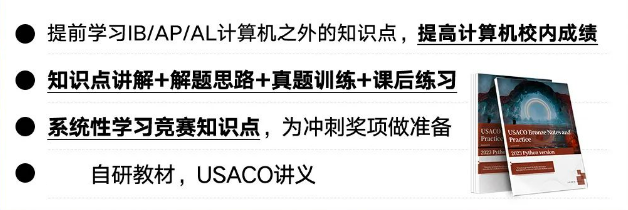美国信息学奥林匹克(USACO)是专门为美国及世界各地的初中和高中生举办的一项计算机编程与算法竞赛。作为一个在线比赛,USACO的普及程度和参与度逐年攀升,吸引了数以千计的学生参与。
USACO竞赛有什么特点?
1、权威性:
由美国官方举办,其成绩在全球范围内受到高度认可。
2、分层晋级机制
分为青铜、白银、黄金和白金四个级别。学生需从青铜级别开始,通过比赛成绩逐步晋级。
3、培养能力全面
不仅考察学生的编程技能,还着重培养逻辑思维、问题解决和算法设计能力。
4、国际影响力
吸引了来自世界各地的优秀学生参与。
USACO准备重点学习内容
- 青铜级别(Bronze):
- 掌握至少一种编程语言。
- 重点复习:模拟(Simulation)、基本完整搜索(Basic Complete Search)、图相关问题(Graph-Related Problems)。
- 白银级别(Silver):
- 培养基本的解决问题能力和简单算法应用(如贪心、递归)。
- 学会在规定时间内找到更优的算法以完成程序。
- 复习重点:前缀和(Prefix Sums)、自定义比较器和坐标压缩(Custom Comparators and Coordinate Compression)、带排序的贪心算法(Greedy Algorithms with Sorting)、二分查找(Binary Search)、深度优先搜索(DFS)和洪水填充算法(Flood Fill)。
- 黄金级别(Gold):
- 在掌握一定算法的基础上,理解抽象方法,如最短路径、动态规划等。
- 复习重点:整除性(Divisibility)、模运算(Modular Arithmetic)、组合数学(Combinatorics)、动态规划简介(Introduction to DP)、广度优先搜索(Breadth First Search, BFS)、并查集(Disjoint Set Union)、滑动窗口(Sliding Window)、点更新区间和(Point Update Range Sum)等问题。
- 铂金级别(Platinum):
- 需要强大的编程基础和对算法的深入理解。
- 能够处理多种答案/优化方案的题目,对考生能力要求极高。
- 复习重点:区间查询与线段树(Range Queries and Segment Tree)、二分跳跃(Binary Jumping)、高级计算几何(Advanced Computational Geometry)、矩阵快速幂(Matrix Exponentiation)等相关问题。
【扫码免费领取】USACO真题+一对一备考规划!
预约最新真题讲座、课程详情可添加下方顾问老师咨询



思维导图










